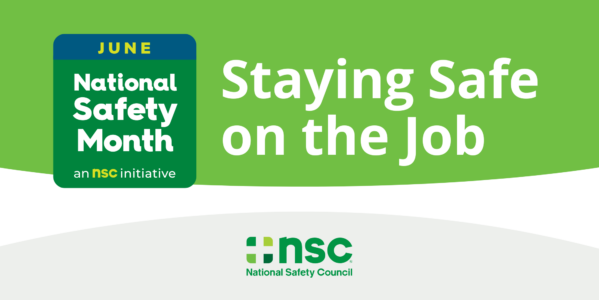Staying Safe on the Job – National Safety Month

In any workplace, prioritizing safety is not just a necessity but a responsibility shared by all. From effective communication channels to the meticulous maintenance of equipment, every aspect contributes to fostering a culture of safety. By adhering to protocols such as wearing appropriate Personal Protective Equipment (PPE), practicing ergonomic principles and maintaining clean workspaces, employees not only protect themselves but also contribute to the overall well-being of the workplace.
Communication: Keeping open lines of communication with colleagues and supervisors regarding safety concerns or incidents is vital for maintaining a safe work environment. This involves promptly reporting any hazards or incidents that may pose a risk to oneself or others. By fostering a culture where safety concerns are openly discussed and addressed, employees can work together to identify potential dangers and implement appropriate preventive measures. If you have a safety concern, please reach out to your FBG representative.
Personal Protective Equipment (PPE): Wearing appropriate PPE for the task at hand is essential for minimizing the risk of injury or exposure to hazards. Whether it’s gloves, goggles, helmets or other protective gear, PPE serves as a crucial barrier between workers and potential workplace hazards. By properly selecting and using PPE according to job requirements and safety guidelines, employees can significantly reduce the likelihood of sustaining injuries or illnesses while performing their duties.
Ergonomics: Maintaining good posture and ergonomic practices is fundamental to preventing musculoskeletal injuries and promoting overall well-being in the workplace. Ergonomic principles involve designing workspaces and tasks to fit the capabilities and limitations of the human body. By ensuring that workstations are ergonomically optimized and encouraging proper lifting techniques and posture, employers can help employees avoid strains, sprains and other physical discomforts associated with repetitive or awkward movements.
Regular Breaks: Taking regular breaks throughout the workday is essential for preventing fatigue-related accidents and maintaining mental and physical well-being. Continuous work without adequate rest can lead to decreased concentration, slower reaction times and increased risk of errors or accidents. By encouraging employees to schedule regular breaks and providing designated rest areas, employers can support productivity and safety by allowing workers to recharge and maintain optimal performance levels.
Housekeeping: Keeping work areas clean and organized is critical for minimizing tripping hazards, preventing slips and falls and maintaining overall workplace safety. Cluttered or poorly maintained workspaces increase the risk of accidents and injuries, as employees may trip over objects or encounter obstacles that obstruct their path. By implementing regular cleaning routines, removing debris and ensuring proper storage of materials and equipment, employers can create a safer work environment and reduce the likelihood of workplace accidents.
Read More: Mastering Housekeeping on the Job
Equipment Maintenance: Regular inspection and maintenance of tools and equipment are essential for ensuring they remain in safe working condition. Malfunctioning or improperly maintained equipment can pose significant risks to employees, ranging from mechanical failures to electrical hazards. By establishing routine maintenance schedules, conducting thorough inspections and promptly addressing any issues or defects, employers can mitigate the risk of accidents and prolong the lifespan of equipment.
Read More: How FBG Prioritizes Safety Year Round